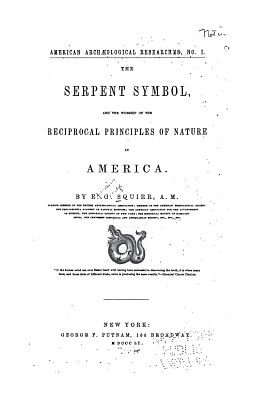
Full PDF online at Google
| Text to be formatted | Images to be added | [CD-Rom Home] |
 Full PDF online at Google |
American Archaeological Researches. No. 1.
New York, April, 1851.
The following numbers of this series are prepared, or far advanced in preparation
CONTENTS.
|
|
I HAVE been for some years engaged upon a work of comprehensive design, in which I propose to bring together, under a single view, all such leading and well authenticated facts as may be accessible, relating to the aboriginal monuments of the American continent, which shall serve to illustrate not only their character and origin, but also the ancient and as yet unwritten history of the New World, and the relation which its aboriginal inhabitants sustained to the great primitive families of the other Continent. A work of this scope and magnitude, it can readily be understood by every one at all acquainted with the subject, must require many years to its completion, especially when, as in my own case, it can only be prosecuted in the intervals of other and more practical duties. Pending, therefore, the submission of this work to the public judgment, I have thought it not improbable that service might be done to the cause of science, by the publication of some of its parts,-if not by adding directly to the stock of new facts and demonstrated results, at least by directing the attention of investigators to subjects hitherto but little considered, but possessed of high interest, and having an important hearing on the grand Archeological and Ethnological problems connected with the history of man in America. In separating these parts from their original connections, where they sustained an intimate relation to other and mutually illustrative chapters, they have necessarily assumed a somewhat '' fragmentary character, with frequent abrupt transitions, some repetitions, and numerous references to foregoing facts and deductions. Circumstances have prevented me from reconstructing them; the only mode in which these defects might be remedied, and in these respects I must crave the indulgence of the critical reader.
The points which I have attempted in some degree to illustrate in the following pages, are the essential identity of some of the elementary religious conceptions of the primitive nations of the Old and New Worlds, and the similarity in their modes of expressing them, or rather the similarity in their symbolical systems, of which I regard the machinery of creation, the multiplication of gods, and the investing of them with attributes, as parts. Upon some of these points the aboriginal monuments of the continent are eminently suggestive; and, as illustrated by the recorded conceptions, known doctrines and rites, and trasmitted traditions of the ancient inhabitants, in many respects, conclusive. Upon these unimpeachable witnesses I have for the most part relied, in arriving at the hypothetical conclusions put forward in these chapters.
It has been remarked by the illustrious Humboldt, that in investigating these subjects, "we shall be surprised to find, towards the end of the fifteenth century, in a world which we call new, those ancient institutions, those religious notions, and that style of building which seem in Asia to indicate the dawn of civilization. The conclusion from thus discovery would naturally be, that these institutions, notions, and monuments, are founded in an original connection, especially as such a conclusion is in strict harmony with popular prejudices. But file philosophical mind will hesitate in accepting it, without inquiring how far similar conditions, and like constitutions, mental, moral, and physical, may serve to approximate institutions, religions, and monuments to a common or cognate type. The opinions of former scholars cannot be taken as conclusive in this inquiry; for at no previous period of file world's history have the materials for prosecuting it been so abundant as now.
The great collateral questions of natural science which have been settled within a few years, the knowledge which maritime and land discoveries have given to us of nearly every nation and people on earth, of their religions, institutions, history, habits, and customs, enabling us to institute comparisons between them all, and to weigh the relations which they sustain toeach other, these are advantages which students have not hitherto enjoyed, and for the want of which no ability could adequately compensate. For no sciences are so eminently inductive as Archaeology and Ethnology, or the sciences of Man and Nations ; none which require so extensive a range of facts to their elucidation.
In pursuing my investigations, I have sought only to arrive at truth, however much it may conflict with preconceived notions, or what are often called " established opinions." I have no system to sustain, no creed to defend; but entertain as many hypotheses as there are possibilities, and claim to be ready to reject or accept according to the weight of evidence and the tendency of facts. In this spirit, I neither fear nor deprecate criticism, but on the contrary, desire it; and so far from regarding him with hostility, who shall, in a proper t' temper, point out what is false in fact or erroneous in deduction, shall esteem the act as a service, and one imposing an obligation deserving of acknowledgment. I reserve to myself, moreover, the privilege of revising, altering, and if need be, of wholly rejecting, whatever may be advanced in this or succeeding volumes; and shall value nothing which may be published, except in so far as it shall meet the rigid requirements of philosophy and truth.